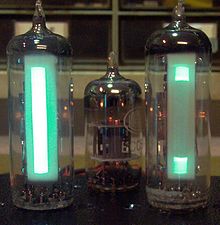EM84

The EM84 is a common display tube (“magic tape”) with a Noval base and two opposing rectangular light strips, the length of which depends on the level of the applied control voltage.
It was developed in 1957 by the Dutch company Philips and at the beginning of the 1960s it largely replaced the display tubes with circular and fan-shaped fluorescent screens.
The EM84 differs from the older display tubes in particular through the fluorescent screen. This is no longer applied to a metal support inside the tube, but directly onto the inner glass surface of the tube bulb. Likewise, the luminous layer was no longer made of pure zinc orthosilicate ( willemite ), but of willemite with an admixture of a certain amount of zinc oxide. Pure willemite loses its luminosity relatively quickly due to the electron bombardment, while the zinc oxide even gains luminosity due to this treatment. This phosphor mixture shows a blue-green cathodoluminescence , while pure willemite here emits a deep green .
A parallel type of the EM84 is the PM84, the heating data of which was adapted to the 0.3 A series heating common in contemporary television receivers.
The EM87 is an EM84 with higher sensitivity. The light bars close the central gap when the control voltage is lower.
The EMM801 was designed for display tasks in connection with the emerging stereophony in the early 1960s, a 'double EM84' in the same bulb with two independent electrode systems for two-channel control.
The EMM803, which is also related, has, in addition to the well-known display system with two bars, a further display system with a much smaller size, which is illuminated when receiving FM stereo broadcasts .
The EM800 is an EM84 with only one light bar that extends over the entire height of the fluorescent screen.
References
- ↑ Literature: Espe, Material Science of High Vacuum Technology, Vol. III, pp. 190ff
literature
- Werner Espe: Materials science of high vacuum technology . tape 3 . VEB Deutscher Verlag der Wissenschaften, Berlin 1961.
Web links
- http://frank.pocnet.net/sheets/010/e/EM84.pdf (PDF file; 152 kB)
- http://frank.pocnet.net/sheets/010/e/EM87.pdf (PDF file; 160 kB)
- http://frank.pocnet.net/sheets/128/e/EMM801.pdf (PDF file; 264 kB)
- http://frank.pocnet.net/sheets/062/e/EMM803.pdf (PDF file; 88 kB)
